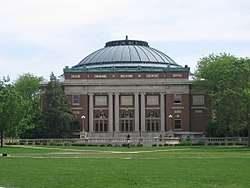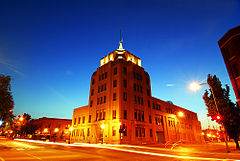University of Illinois at Urbana–Champaign
The University of Illinois at Urbana–Champaign (U of I, Illinois, or colloquially the University of Illinois or UIUC)[7][8] is a public land-grant research university in Illinois in the twin cities of Champaign and Urbana. It is the flagship institution of the University of Illinois system and was founded in 1867.
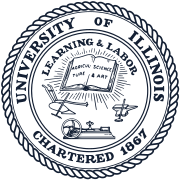 | |
Former names | Illinois Industrial University (1867–1885) University of Illinois (1885–1982) |
|---|---|
| Motto | Learning & Labor |
| Type | Public, Land-grant |
| Established | 1867 |
Academic affiliations | |
| Endowment | $2.35 billion (2019)[1] |
| Chancellor | Robert J. Jones[2] |
| Provost | Andreas C. Cangellaris[3] |
Academic staff | 2,548 |
Administrative staff | 7,801 |
| Students | 51,196 (Fall 2019)[4] |
| Undergraduates | 33,850 (Fall 2019)[4] |
| Postgraduates | 16,319 (Fall 2019)[4] |
| Location | , , United States |
| Campus | Urban, 6,370 acres (2,578 ha)[5] |
| Newspaper | The Daily Illini |
| Colors | Orange and Blue[6] |
| Nickname | Fighting Illini |
Sporting affiliations | NCAA Division I FBS – Big Ten |
| Website | www |
The University of Illinois at Urbana–Champaign is a member of the Association of American Universities and is classified among "R1: Doctoral Universities – Very high research activity".[9] In fiscal year 2019, research expenditures at Illinois totaled $652 million.[10][11] The campus library system possesses the second-largest university library in the United States by holdings after Harvard University.[12] The university also hosts the National Center for Supercomputing Applications (NCSA) and is home to the fastest supercomputer on a university campus.[13]
The university contains 16 schools and colleges[14] and offers more than 150 undergraduate and over 100 graduate programs of study. The university holds 651 buildings on 6,370 acres (2,578 ha)[5] and its annual operating budget in 2016 was over $2 billion.[15] The University of Illinois at Urbana–Champaign also operates a Research Park home to innovation centers for over 90 start-up companies and multinational corporations, including Abbott, AbbVie, Caterpillar, Capital One, Dow, State Farm, and Yahoo, among others.[11]
As of January 2020, the alumni of the university include 11 Nobel laureates (additionally 14 in its faculty), 2 Rhodes Scholars, 6 NASA astronauts, 3 Marshall Scholars, 70 Fulbright scholars, 1 Fields medalist, 25 Pulitzer Prize winners (additionally 3 in its faculty), and 2 Turing Award winners. Illinois athletic teams compete in Division I of the NCAA and are collectively known as the Fighting Illini. They are members of the Big Ten Conference and have won the second-most conference titles. Illinois Fighting Illini football won the Rose Bowl Game in 1947, 1952, 1964 and a total of five national championships. Illinois athletes have won 29 medals in Olympic events, ranking it among the top 40 American universities with Olympic medals.
History
Illinois Industrial University

The University of Illinois, originally named "Illinois Industrial University", was one of the 37 universities created under the first Morrill Land-Grant Act, which provided public land for the creation of agricultural and industrial colleges and universities across the United States. Among several cities, Urbana was selected in 1867 as the site for the new school.[17][18] From the beginning, President John Milton Gregory's desire to establish an institution firmly grounded in the liberal arts tradition was at odds with many state residents and lawmakers who wanted the university to offer classes based solely around "industrial education".[19] The university opened for classes on March 2, 1868, and had two faculty members and 77 students.[20]
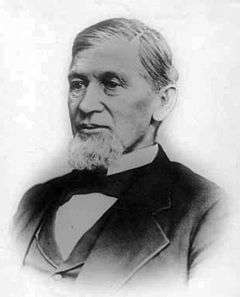
The Library, which opened with the school in 1868, started with 1,039 volumes. Subsequently, President Edmund J. James, in a speech to the board of trustees in 1912, proposed to create a research library. It is now one of the world's largest public academic collections.[18][21][22] In 1870, the Mumford House was constructed as a model farmhouse for the school's experimental farm. The Mumford House remains the oldest structure on campus.[23] The original University Hall (1871) was the fourth building built; it stood where the Illini Union stands today.[24]
University of Illinois
In 1885, the Illinois Industrial University officially changed its name to the "University of Illinois", reflecting its agricultural, mechanical, and liberal arts curriculum.[19]
During his presidency, Edmund J. James (1904–1920) is credited for building the foundation for the large Chinese international student population on campus.[25][26][27][28] James established ties with China through the Chinese Minister to the United States Wu Ting-Fang.[28] In addition, during James's presidency, class rivalries and Bob Zuppke's winning football teams contributed to campus morale.[18]
Alma Mater, a prominent statue on campus created by alumnus Lorado Taft, was unveiled on June 11, 1929. It was established from donations by the Alumni Fund and the classes of 1923–1929.[29]
Like many universities, the economic depression slowed construction and expansion on the campus. The university replaced the original university hall with Gregory Hall and the Illini Union. After World War II, the university experienced rapid growth. The enrollment doubled and the academic standing improved.[30] This period was also marked by large growth in the Graduate College and increased federal support of scientific and technological research. During the 1950s and 1960s the university experienced the turmoil common on many American campuses. Among these were the water fights of the fifties and sixties.[31]
University of Illinois at Urbana–Champaign
By 1967 the University of Illinois system consisted of a main campus in Champaign-Urbana and two Chicago campuses, Chicago Circle (UICC) and Medical Center (UIMC), and people began using "Urbana–Champaign" or the reverse to refer to the main campus specifically. The university name officially changed to the "University of Illinois at Urbana–Champaign" around 1982. While this was a reversal of the commonly used designation for the metropolitan area, "Champaign-Urbana," most of the campus is located in Urbana. The name change established a separate identity for the main campus within the University of Illinois system, which today includes campuses in Springfield (UIS) and Chicago (UIC) (formed by the merger of UICC and UIMC).
In 1998, the Hallene Gateway Plaza was dedicated. The Plaza features the original sandstone portal of University Hall, which was originally the fourth building on campus.[24] In recent years, state support has declined from 4.5% of the state's tax appropriations in 1980 to 2.28% in 2011, a nearly 50% decline.[32] As a result, the university's budget has shifted away from relying on state support with nearly 84% of the budget now coming from other sources.[33]
On March 12, 2015, the Board of Trustees approved the creation of a medical school, being the first college created at Urbana–Champaign in over 60 years.[34][35][36] The Carle-Illinois College of Medicine began classes in 2018.[37]
Campus
The main research and academic facilities are divided almost evenly between the twin cities of Urbana and Champaign, which form part of the Champaign–Urbana metropolitan area. The College of Agriculture, Consumer, and Environmental Sciences' research fields stretch south from Urbana and Champaign into Savoy and Champaign County. The university maintains formal gardens and a conference center in nearby Monticello at Allerton Park. Four main quads compose the center of the university and are arranged from north to south. The Beckman Quadrangle and the John Bardeen Quadrangle occupy the center of the Engineering Campus. Boneyard Creek flows through the John Bardeen Quadrangle, paralleling Green Street. The Beckman Quadrangle, named after Arnold Orville Beckman, is primarily composed of research units and laboratories, and features a large solar calendar consisting of an obelisk and several copper fountains. The Main Quadrangle and South Quadrangle follow immediately after the John Bardeen Quad. The former makes up a large part of the Liberal Arts and Sciences portion of the campus, while the latter comprises many of the buildings of the College of ACES spread across the campus map.[38]
The campus is known for its landscape and architecture, as well as distinctive landmarks.[39] It was identified as one of 50 college or university "works of art" by T.A. Gaines in his book The Campus as a Work of Art.[40] The campus also has a number of buildings and sites on the U.S. National Register of Historic Places including Harker Hall, Astronomical Observatory, Louise Freer Hall, the Main Library, the Experimental Dairy Farm Historic District, and the Morrow Plots. The University of Illinois Willard Airport is one of the few airports owned by an educational institution.[41]
Sustainability
In October 2011, the Sustainable Endowments Institute gave the campus a grade of B for sustainability in its 2011 College Sustainability Report Card. Strengths noted in the report included the campus's adoption of LEED gold standards for all new construction and major renovations and its public accessibility to endowment investment information. The university makes a list of endowment holdings and its shareholder voting record available to the public. The weaknesses are areas such as student involvement and investment priorities. The Student Sustainability Committee is empowered to allocate funding from a clean energy technology fee and a sustainable campus environment fee,[42] while the university aims to optimize investment return but has not made any public statements about investigating or investing in renewable energy funds or community development loan funds. However, the biggest weakness of the university's sustainability is its shareholder engagement, as the university has not made any public statements about active ownership or a proxy voting policy.[43]
Currently, the University of Illinois has 11 LEED certified buildings. Three of these are platinum certified (Business Instructional Facility, Lincoln Hall, and Bousfield Hall). Three are gold (National Petascale Computing Facility, Nugent Hall, Wassaja Hall). The rest are silver (Ikenberry Dining Hall, Evers Laboratory, Newmark Civil Engineering Laboratory, Illinois Fire Service Institute, and Huff Hall).[44]
In his remarks on the creation of the Office of Sustainability in September 2008, Chancellor Richard Herman stated, "I want this institution to be the leader in sustainability."[45] In February 2008, he signed the American College and University Presidents Climate Commitment, committing the University of Illinois to take steps "in pursuit of climate neutrality."[46]
Sexual harassment and 2018 lawsuit
In September 2018, a lawsuit was filed against the former head of the East Asian Language and Culture Department at the university, alleging "a reign of terror that includes accusations of preying on young Chinese women and sexually assaulting students."[47] Former students and another professor, through sexual harassment attorney Ann Olivarius, are suing Gary Xu, who worked at the university from 2006 until 2018, when he was “allowed to resign.” The lawsuit claims Xu specifically targeted female Chinese students, who often depended on the university for their visa status. He allegedly raped and beat one of his students repeatedly.[48] The lawsuit states that after the university prepared a report on Xu's violent abuse of students, he was allowed to remain on the faculty as a professor at full pay for two years, and then the university gave him a $10,000 departure bonus when he resigned. The lawsuit, served to Xu by email in December 2019 after unsuccessful attempts to serve him in person, "seeks damages and unpaid wages on 10 allegations, including emotional distress, gender violence, involuntary servitude, forced labor and sex trafficking."[49][50]
An investigation by ProPublica and National Public Radio (NPR Illinois) in August 2019 revealed numerous instances of "allegations of harassment and sexual misconduct" against professors and an administrator at the university, none of which were publicly reported.[51] Several, such as anthropology professor Mahir Saul and law professor Jay Kesan, are still employed or affiliated with the university.[52]
Academics
| University of Illinois at Urbana–Champaign | |
|---|---|
| College/School | |
| Agriculture, Consumer, and Environmental Sciences | |
| Fine and Applied Arts | |
| Grainger College of Engineering | |
| Medicine | |
| Information Sciences | |
| Applied Health Sciences | |
| Law | |
| Education | |
| Liberal Arts and Sciences | |
| Gies College of Business | |
| Media | |
| Social Work | |
| Aviation | |
| Labor and Employment Relations | |
| Veterinary Medicine | |
| Carle-Illinois College of Medicine | |
The university offers more than 150 undergraduate and 100 graduate and professional programs in over 15 academic units, among several online specializations such as Digital Marketing and an online MBA program launched in January 2016. In 2015, the university announced its expansion to include an engineering-based medical program, which would be the first new college created in Urbana–Champaign in over 60 years.[35][36] The university also offers Undergraduate students the opportunity for graduation honors. University Honors is an academic distinction awarded to the highest achieving students. To earn the distinction, students must have a cumulative grade point average of a 3.5/4.0 within the academic year of their graduation and rank within the top 3% of their graduating class. Their names are inscribed on a Bronze Tablet that hangs in the Main Library.[53]
Several scholar opportunities include "James Scholars" where undergraduate students invited to pursue a specialized course of study for no less than two years of their undergraduate course work, "Chancellor's Scholars" where undergraduate students are invited to participate in the Campus Honors Program (only 125 members admitted per year), and "Senior 100 Honorary", which recognizes graduates for achievements in leadership, academics and campus involvement throughout their undergraduate education.
The Leadership Certificate is a multi-semester structured program which aims to develop students' leadership skills through different kinds of curricula and programs.[54]
Admissions
Admission to UIUC is rated as "more selective" by U.S. News & World Report.[55] Admissions differ between the different colleges/schools in the university. The School of Social Work has the lowest ranges with the middle 50% range of the ACT at 24–27, and the middle 50% range of the SAT is 1150–1350 (out of 1600; for critical reading and math only). The middle 50% high school class rank is 74–90%.[56] The schools start to make a more significant increase with the College of Liberal Arts and Sciences. The middle 50% range for the ACT is 27–32, the SAT (no writing) is 1320–1450, and the high school class rank is 85–97%.[56] The middle 50% range for the ACT and SAT (no writing) for the Gies College of Business are 28–32, 1320–1440 and the high school class rank is 88–97%.[56] The most selective college is the College of Engineering. The middle 50% range for the ACT is 31–34, the SAT (no writing) is 1400–1520, and the high school class rank is 92–99%.[56]
For the freshmen who were admitted for the 2018 school year, the middle 50% range of the ACT composite was 27–33.[56] The middle 50% range for the SAT was 1270-1480.
In 2009, an investigation by Chicago Tribune reported that some applicants "received special consideration" for acceptance between 2005 and 2009, despite having sub-par qualifications.[57]
Distance learning
In addition to the university's Illinois Online platform, in 2015 the university entered into a partnership with the Silicon Valley educational technology company Coursera to offer a series of master's degrees and specialization courses, currently including more than 70 joint learning classes. In August 2015, the Master of Business Administration program was launched through the platform.[58] On March 31, 2016, Coursera announced the launch of the Master of Computer Science in Data Science from the University of Illinois at Urbana–Champaign.[59] At the time, the university's computer-science graduate program was ranked fifth in the United States by U.S. News & World Report.[60] On March 29, 2017, the University of Illinois at Urbana–Champaign launched their Master's in Accounting (iMSA) program, now called the Master of Science in Accountancy (iMSA) program. The iMSA program is led through live sessions, headed by UIUC faculty.[61]
Similar to the university's on-campus admission policies, the online master's degrees offered by The University of Illinois through Coursera also have strict admission requirements. All applicants must hold a bachelor's degree, and have earned a 3.0 GPA or higher in the last two years of study. Additionally, all applicants must prove their proficiency in English.[62][63][62]
Rankings
|
|
| ||||||||||||||||||||||||||||||||||||||||||||||||||||||||||||||||||||||||||||||||||||||||||||||||||||||||||||||||||||||||||||||||||
In the 2020 U.S. News & World Report (USNWR) "America's Best Colleges" report, UIUC's undergraduate program was ranked tied for 48th among national universities and tied for 14th among public universities, with its undergraduate engineering program ranked tied for 6th in the U.S. among schools whose highest degree is a doctorate.[75] The graduate program had 24 programs ranked within the top 25 nationwide by USNWR, including 8 within the top five.[76] U.S. News & World Report's 2020 graduate school rankings include the School of Information Sciences at 1st in the nation, with six programs ranked within the top ten; the Gies College of Business tied for 47th nationally, with the accounting program at number 2; the College of Engineering ranked 10th at the graduate level, with 9 programs ranked within the top ten; the College of Education was ranked tied for 50th overall, with 2 programs ranked in the top ten; and the School of Law was ranked tied for 39th.[76]
Washington Monthly ranked UIUC 17th among national universities in the U.S. for 2019, based on its contribution to the public good as measured by social mobility, research, and promoting public service.[77] Kiplinger's Personal Finance rated Illinois 12th in its 2019 list of 174 Best Values in Public Colleges,[78] which "measures academic quality, cost and financial aid."
The Graduate Program in Urban Planning at the College of Fine and Applied Arts was ranked 3rd nationally by Planetizen in 2015.[79] The university was also listed as a "Public Ivy" in The Public Ivies: America's Flagship Public Universities (2001) by Howard and Matthew Greene.[80] The Princeton Review ranked Illinois 1st in its 2016 list of top party schools.[81]
Internationally, UIUC engineering was ranked 13th in the world in 2016 by the Academic Ranking of World Universities (ARWU) and the university 38th in 2019;[82] the university was also ranked 48th globally by the Times Higher Education World University Rankings in 2020 and 75th in the world by the QS World University Rankings for 2020. The Center for World University Rankings (CWUR) has ranked University of Illinois at Urbana–Champaign as the 20th best university in the world for 2019-20.[83]
UIUC is also ranked 32nd in the world in Times Higher Education World Reputation Rankings for 2018.[84] Nature Index ranks UIUC 33rd among top Academic institutions in the world.[85]
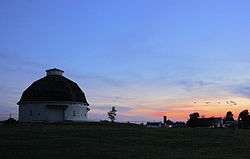
Research
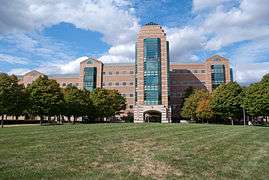
The University of Illinois at Urbana–Champaign is often regarded as a world-leading magnet for engineering and sciences (both applied and basic).[86] Having been classified into the category comprehensive doctoral with medical/veterinary and very high research activity by The Carnegie Foundation for the Advancement of Teaching,[9] Illinois offers a wide range of disciplines in undergraduate and postgraduate programs.
According to the National Science Foundation, the university spent $625 million on research and development in 2018, ranking it 37th in the nation.[10][11] It is also listed as one of the Top 25 American Research Universities by The Center for Measuring University Performance.[87] Beside annual influx of grants and sponsored projects, the university manages an extensive modern research infrastructure.[88] The university has been a leader in computer based education and hosted the PLATO project, which was a precursor to the internet and resulted in the development of the plasma display. Illinois was a 2nd-generation ARPAnet site in 1971 and was the first institution to license the UNIX operating system from Bell Labs.
Research Park
Located in the southwest part of campus, Research Park opened its first building in 2001 and has grown to encompass 13 buildings. Ninety companies have established roots in research park, employing over 1,400 people. Tenants of the Research Park facilities include prominent Fortune 500 companies Capital One, John Deere, State Farm, Caterpillar, and Yahoo, Inc. Companies also employ about 400 total student interns at any given time throughout the year. The complex is also a center for entrepreneurs, and has over 50 startup companies stationed at its EnterpriseWorks Incubator facility.[89]
In 2011, Urbana, Illinois was named number 11 on Popular Mechanics' "14 Best Startup Cities in America" list, in a large part due to the contributions of Research Park's programs.[90] The park has gained recognition from other notable publications, such as inc.com and Forbes magazine. For the 2011 fiscal year, Research Park produced an economic output of $169.5M for the state of Illinois.[91]
National Center for Supercomputing Applications
The university hosts the National Center for Supercomputing Applications (NCSA), which created Mosaic, the first graphical Web browser, the foundation upon which the former Netscape was based on and Mozilla Firefox and Microsoft Internet Explorer are based, the Apache HTTP server, and NCSA Telnet. The Parallel@Illinois program hosts several programs in parallel computing, including the Universal Parallel Computing Research Center. The university contracted with Cray to build the National Science Foundation-funded supercomputer Blue Waters[92][93][94] The system also has the largest public online storage system in the world with more than 25 petabytes of usable space.[95] The university celebrated January 12, 1997 as the "birthday" of HAL 9000, the fictional supercomputer from the novel and film 2001: A Space Odyssey; in both works, HAL credits "Urbana, Illinois" as his place of operational origin.
Prairie Research Institute
The Prairie Research Institute is located on campus and is the home of the Illinois Natural History Survey, Illinois State Geological Survey, Illinois State Water Survey, Illinois Sustainable Technology Center, and the Illinois State Archeological Survey. Researchers at the Prairie Research Institute are engaged in research in agriculture and forestry, biodiversity and ecosystem health, atmospheric resources, climate and associated natural hazards, cultural resources and history of human settlements, disease and public health, emerging pests, fisheries and wildlife, energy and industrial technology, mineral resources, pollution prevention and mitigation, and water resources. The Illinois Natural History Survey collections include crustaceans, reptiles and amphibians, birds, mammals, algae, fungi, and vascular plants, with the insect collection is among the largest in North America. The Illinois State Geological Survey houses the legislatively mandated Illinois Geological Samples Library, a repository for drill-hole samples in Illinois, as well as paleontological collections. ISAS serves as a repository for a large collection of Illinois archaeological artifacts. One of the major collections is from the Cahokia Mounds.[96]
Accolades
In Bill Gates' February 24, 2004 talk as part of his Five Campus Tour (Harvard, MIT, Cornell, Carnegie-Mellon and Illinois)[97] titled "Software Breakthroughs: Solving the Toughest Problems in Computer Science," he mentioned that Microsoft hires more graduates from the University of Illinois at Urbana–Champaign than from any other university in the world.[98] Alumnus William M. Holt, a Senior Vice-President of Intel, also mentioned in a campus talk on September 27, 2007, entitled "R&D to Deliver Practical Results: Extending Moore's Law"[99] that Intel hires more PhD graduates from the University of Illinois at Urbana–Champaign than from any other university in the country.
In 2007, the university-hosted research Institute for Condensed Matter Theory (ICMT) was launched, with the director Paul Goldbart and the chief scientist Anthony Leggett. ICMT is currently located at the Engineering Science Building on campus.
The University Professional and Continuing Education Association (UPCEA), which recognizes excellence in both individual and institutional achievements, has awarded two awards to U of I.[100]
Entrepreneurship
Through different departments, programs, and registered student organizations, the University of Illinois encourages students to become entrepreneurs through competitions, mentoring, and advising.[101]
Technology Entrepreneur Center
The Technology Entrepreneur Center at the University of Illinois at Urbana Champaign is a permanent center established to provide students with resources for their entrepreneurial ideas. The center offers classes, venture and product competitions, and workshops to introduce students to technology innovation and market adoption.[102] Events and programs hosted by the TEC include the Cozad New Venture Challenge, Silicon Valley Entrepreneurship Workshop, Illinois I-Corps, and SocialFuse. The campus-wide Cozad New Venture Challenge has been held annually since 2000. Participants are mentored in the phases of venture creation and attend workshops on idea validation, pitching skills, and customer development. In 2019, teams competed for $250,000 in funding.[103] The Silicon Valley Workshop is a week-long workshop, occurring annually in January. Students visit startups and technology companies in the Silicon Valley and network entrepreneurial alumni from the University of Illinois at Urbana Champaign. Students are exposed to technology entrepreneurship, innovation, and leadership. The trip features corporate leaders, venture capitalists, and entrepreneurs in various stages of a startup lifecycle.[104] Illinois I-Corps teaches National Science Foundation grantees how to learn to identify valuable product opportunities that can emerge from academic research, and gain skills in entrepreneurship through training in customer discovery and guidance from established entrepreneurs. [105] The program is a collaboration between the Technology Entrepreneur Center and EnterpriseWorks, with participation from the Office of Technology Management and IllinoisVentures. The program consists of 3 workshops over 6 weeks, where teams work to validate the market size, value propositions, and customer segments of their innovations. [106] SocialFuse is a recurring pitching and networking event where students can pitch ideas, find teammates, and network. [107]
Discoveries and innovation
Natural sciences
- BCS theory – John Bardeen, in collaboration with Leon Cooper and his doctoral student John Robert Schrieffer, proposed the standard theory of superconductivity known as the BCS theory (named for their initials). They shared the Nobel Prize in Physics 1972 for their discovery.[108]
- Sweet corn – John Laughnan produced corn with higher than normal levels of sugar while he was a professor at the university.[109]
Computer & applied sciences
- ILLIAC I – (Illinois Automatic Computer), a pioneering computer built in 1952 by the University of Illinois, was the first computer built and owned entirely by a US educational institution. Lejaren Hiller, in collaboration with Leonard Issacson, programmed the ILLIAC I computer at the University of Illinois at Urbana–Champaign (where both composers were professors) to generate compositional material for his String Quartet No. 4.[110]
- ILLIAC Suite – is a 1957 composition for string quartet which is generally agreed to be the first score composed by an electronic computer.[111]
- LLVM – compiler infrastructure project (formerly Low Level Virtual Machine). Vikram Adve (professor) and Chris Lattner started development as a research assistant and M.Sc. student.[112]
- Mosaic (web browser) – The first successful consumer web browser was developed at the National Center for Supercomputing Applications (NCSA) at the University of Illinois Urbana–Champaign released in 1993.[113]
- PLATO – (Programmed Logic for Automatic Teaching Operations)[114] was the first generalized computer assisted instruction system. Starting in 1960, it ran on the University of Illinois' ILLIAC I computer. By the late 1970s, it supported several thousand graphics terminals distributed worldwide, running on nearly a dozen different networked mainframe computers. Many modern concepts in multi-user computing were developed on PLATO, including forums, message boards, online testing, e-mail, chat rooms, picture languages, instant messaging, remote screen sharing, and multiplayer video games.[115]
- Touchscreens & Plasma displays – developed by Donald Bitzer in the 1960s.[116]
- Talkomatic – (http://talko.cc/) is an online chat system[117] that facilitates real-time text communication among a small group of people. created by Doug Brown and David R. Woolley in 1973 on the PLATO System.[118]
- Synchronized Sound-on-film – Joseph Tykociński-Tykociner publicly demonstrated for the first time a motion picture with a soundtrack optically recorded directly onto the film June 9, 1922.[119]
Companies & entrepreneurship
UIUC alumni and faculty have founded numerous companies and organizations, some of which are shown below.[120][121][122]
- Andreessen Horowitz, 2009, co-founder Marc Andreessen (B.S.)
- Advanced Micro Devices (AMD), 1969, co-founder Jerry Sanders (B.S).
- Arizona Diamondbacks, 1995, founder, Jerry Colangelo (B.A.)
- Beckman Coulter, 1935, founder Arnold Orville Beckman (B.S, M.S).
- BET, 1980, co-founder Robert L. Johnson (B.A.)
- Chicago Bears, 1920, founder George Halas
- Girls Who Code, 2012, founder Reshma Saujani (B.A.)
- Harlem Globetrotters, 1926, founder Abe Saperstein
- National Football League, 1920, co-founder George Halas
- Netscape, 1994, co-founder Marc Andreessen (B.S).
- Oracle, 1977, co-founders Larry Ellison (dropout) and Bob Miner (B.S).
- PayPal (Confinity), 1998, co-founders Luke Nosek (B.S) and Max Levchin (B.S).
- Playboy Enterprises, 1953, founder Hugh Hefner (B.A).
- Siebel Systems, 1993, co-founder Thomas Siebel (B.A, M.S, M.B.A).
- Tesla, 2003, co-founder Martin Eberhard (B.S,. M.S).
- W. W. Grainger, 1927, founder William Wallace Grainger (B.S.)
- Yelp, 2004, founders Jeremy Stoppelman (B.S) and Russel Simmons (B.S).
- YouTube, 2005, co-founders Steve Chen (B.S) and Jawed Karim (B.S).
Student life
Enrollment
As of spring 2018, the university had 45,813 students.[123] As of 2015, over 10,000 students were international students, and of them 5,295 were Mainland Chinese.[124] The university also recruits students from over 100 countries[125][126] among its 32,878[127] undergraduate students and 10,245[127] graduate and professional students.[126] The gender breakdown is 55% men, 45% women.[126] UIUC in 2014 enrolled 4,898 students from China, more than any other American university. They comprise the largest group of international students on the campus, followed by South Korea (1,268 in fall 2014) and India (1,167). Graduate enrollment of Chinese students at UIUC has grown from 649 in 2000 to 1,973 in 2014.[128]
Student organizations
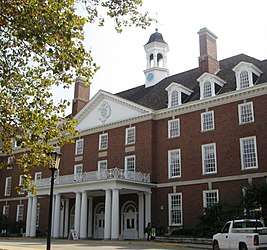
The university has over 1,000 active registered student organizations,[129] showcased at the start of each academic year during Illinois's "Quad Day." Registration and support is provided by the Student Programs & Activities Office, an administrative arm established in pursuit of the larger social, intellectual, and educative goals of the Illini Student Union. The Office's mission is to "enhance ... classroom education," "meet the needs and desires of the campus community," and "prepare students to be contributing and humane citizens."[130] Beyond student organizations, The Daily Illini is a student-run newspaper that has been published for the community of since 1871. The paper is published by Illini Media Company, a not-for-profit which also prints other publications, and operates WPGU 107.1 FM, a student-run commercial radio station. The Varsity Men's Glee Club is an all-male choir at the University of Illinois that was founded in 1886.[131] The Varsity Men's Glee Club[132] is one of the oldest glee clubs in the United States as well as the oldest registered student organisation at the University of Illinois. As of 2018, the University also has the largest chapter of Alpha Phi Omega with over 340 active members.[133]
Greek life
There are 59 fraternities and 38 sororities on campus.[134] Of the approximately 30,366 undergraduates, 3,463 are members of sororities and 3,674 are members of fraternities.[135] The Greek system at the University of Illinois at Urbana–Champaign has a system of self-government. While staff advisors and directors manage certain aspects of the Greek community, most of the day-to-day operations of the Greek community are governed by the Interfraternity Council and Panhellenic Council.[136] A smaller minority of fraternities and sororities fall under the jurisdiction of the Black Greek Council and United Greek Council; the Black Greek Council serves "historically black" Greek organizations while the United Greek council comprises other multicultural organizations.[137][138] Many of the fraternity and sorority houses on campus are on the National Register of Historic Places.
Student government
U of I has an extensive history of past student governments. Two years after the university opened in 1868, John Milton Gregory and a group of students created a constitution for a student government. Their governance expanded to the entire university in 1873, having a legislative, executive, and judicial branch. For a period of time, this government had the ability to discipline students. In 1883, however, due to a combination of events from Gregory's resignation to student-faculty infighting, the government formally dissolved itself via plebiscite.[139]
It wasn't until 1934, when the Student Senate, the next university-wide student government, was created. A year before, future U of I Dean of Students, Fred H. Turner and the university's Senate Committee on Student Affairs gave increased power to the Student Council, an organization primarily known for organizing dances. A year after, the Student Council created a constitution and became the Student Senate, under the oversight of the Committee on Student Affairs. This Student Senate would last for 35 years.[140] The Student Senate changed its purpose and name in 1969, when it became the Undergraduate Student Association (UGSA). It no longer was a representational government, instead becoming a collective bargaining agency. It often worked with the Graduate Student Association to work on various projects[141]
In 1967, Bruce A. Morrison and other U of I graduates founded the Graduate Student Association (GSA). GSA would last until 1978, when it merged with the UGSA to form the Champaign-Urbana Student Association (CUSA).[142][143] CUSA lasted for only 2 years when it was replaced by the Student Government Association (SGA) in 1980. SGA lasted for 15 years until it became the Illinois Student Government (ISG) in 1995. ISG lasted until 2004.[143]
The current university student government, created in 2004, is the Illinois Student Senate, a combined undergraduate and graduate student senate with 54 voting members. The student senators are elected by college and represent the students in the Urbana–Champaign Senate (which comprises both faculty and students), as well as on a variety of faculty and administrative committees, and are led by an internally elected executive board of a President, External Vice President, Internal Vice President, and Treasurer. As of 2012, the executive board is supported by an executive staff consisting of a Chief of Staff, Clerk of the Senate, Parliamentarian, Director of Communications, Intern Coordinator, and the Historian of the Senate.[144]
Residence halls
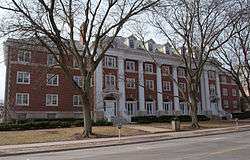
University housing for undergraduates is provided through twenty-four residence halls in both Urbana and Champaign. Incoming freshmen are required to live in student housing (campus or certified) their first year on campus. Graduate housing is usually offered through two graduate residence halls, restricted to students who are sophomores or above, and through three university-owned apartment complexes. Some undergraduates choose to move into apartments or the Greek houses after their second year. There are a number of private dormitories around campus, as well as 15 private, certified residences that partner with the university to offer a variety of different housing options, including ones that are cooperatives, single-gender or religiously-affiliated.[145] The university is known for being one of the first universities to provide accommodations for students with disabilities.[146] Currently, most first-year students with disabilities will live in Nugent Hall, supported by the Beckwith Residential Support Services.[147] In 2015, the University of Illinois announced that they would be naming its newest residence hall after Carlos Montezuma also known as Wassaja. Wassaja is the first Native American graduate and is believed to be one of the first Native Americans to receive a medical degree.[148]
Libraries and museums
The campus library system is one of the largest public academic collections in the world.[21] Among universities in North America, only the collections of Harvard are larger.[149] Currently, the University of Illinois' 20+ departmental libraries and divisions hold more than 24 million items, including more than 12 million print volumes.[21] As of 2012, it had also the largest "browsable" university library in the United States, with 5 million volumes directly accessible in stacks in a single location.[150] University of Illinois also has the largest public engineering library (Grainger Engineering Library) in the country.[151][21][152] In addition to the main library building, which houses nearly 10 subject-oriented libraries, the Isaac Funk Family Library on the South Quad serves the College of Agriculture, Consumer, and Environmental Sciences and the Grainger Engineering Library Information Center serves the College of Engineering on the John Bardeen Quad.
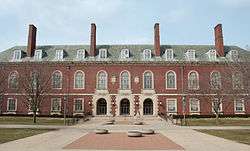
Residence Hall Library System is one of three in the nation.[153][154] The Residence Hall Libraries were created in 1948 to serve the educational, recreational, and cultural information needs of first and second year undergraduate students residing in the residence halls, and the living-learning communities within the residence halls. The collection also serves University Housing staff as well as the larger campus community, including undergraduate and graduate students, and university faculty and staff.[155] The Rare Book & Manuscript Library (RBML) is one of the Special collections units within the University Library.[156] The RBML is one of the largest special collections repositories in the United States.[157][158][159][160]
The university has several museums, galleries, and archives which include Krannert Art Museum, Sousa Archives and Center for American Music and Spurlock Museum. Gallery and exhibit locations include Krannert Center for the Performing Arts and at the School of Art and Design.
Recreation
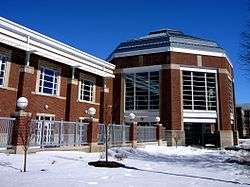
The campus has two main recreation facilities, the Activities and Recreation Center (ARC) and the Campus Recreation Center – East (CRCE). Originally known as the Intramural Physical Education Building (IMPE) and opened in 1971, IMPE was renovated in 2006 and reopened in August 2008 as the ARC.[161] The renovations expanded the facility, adding 103,433 square feet to the existing structure and costing $54.9 million. This facility is touted by the university as "one of the country's largest on-campus recreation centers." CRCE was originally known as the Satellite Recreation Center, and was opened in 1989. The facility was renovated in 2005 to expand the space and update equipment, officially reopening in March 2005 as CRCE.[162]
Transportation
The bus system that operates throughout the campus and community is operated by the Champaign-Urbana Mass Transit District. The MTD receives a student-approved transportation fee from the university, which provides unlimited access for university students. In addition, the university pays for universal access for all its faculty and staff.
Six daily Amtrak trains connect Champaign-Urbana with Chicago and Carbondale (IL). The City of New Orleans train also serves Memphis, Jackson, Mississippi, and New Orleans.
Willard Airport, opened in 1954 and is named for former University of Illinois president Arthur Cutts Willard. The airport is located in Savoy. Willard Airport is home to University research projects and the university's Institute of Aviation, along with flights from American Airlines.
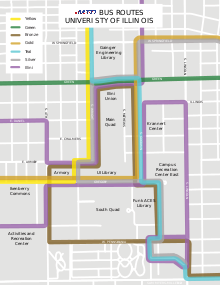
Athletics
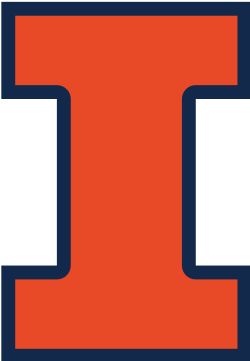
U of I's Division of Intercollegiate Athletics fields teams for ten men's and eleven women's varsity sports. The university participates in the NCAA's Division I. The university's athletic teams are known as the Fighting Illini. The university operates a number of athletic facilities, including Memorial Stadium for football, the State Farm Center for men's and women's basketball, and the Atkins Tennis Center for men's and women's tennis. The men's NCAA basketball team had a dream run in the 2005 season, with Bruce Weber's Fighting Illini tying the record for most victories in a season. Their run ended 37–2 with a loss to the North Carolina Tar Heels in the national championship game. Illinois is a member of the Big Ten Conference. Notable among a number of songs commonly played and sung at various events such as commencement and convocation, and athletic games are: Illinois Loyalty, the school song, Oskee Wow Wow, the fight song, and Hail to the Orange, the alma mater.
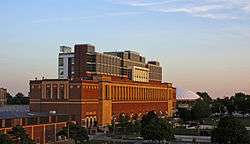
On October 15, 1910, the Illinois football team defeated the University of Chicago Maroons with a score of 3–0 in a game that Illinois claims was the first homecoming game, though several other schools claim to have held the first homecoming as well.[164][165] On November 10, 2007, the unranked Illinois football team defeated the No. 1 ranked Ohio State football team in Ohio Stadium, the first time that the Illini beat a No. 1 ranked team on the road.
The University of Illinois Ice Arena is home to the university's club college ice hockey team competing at the ACHA Division I level and is also available for recreational use through the Division of Campus Recreation. It was built in 1931 and designed by Chicago architecture firm Holabird and Root, the same firm that designed the University of Illinois Memorial Stadium and Chicago's Soldier Field. It is located on Armory Drive across from the Armory. The structure features 4 rows of bleacher seating in an elevated balcony that runs the length of the ice rink on either side. These bleachers provide seating for roughly 1,200 fans, with standing room and bench seating available underneath. Because of this set-up the team benches are actually directly underneath the stands.[166]
In 2015, the university began Mandarin Chinese broadcasts of its American football games as a service to its Chinese international students.[124]
Chief Illiniwek
Chief Illiniwek, also referred to as "The Chief," was from 1926 to 2007 the official symbol of the University of Illinois in university intercollegiate athletic programs. The Chief was typically portrayed by a student dressed in Sioux regalia. Several groups protested that the use of a Native American figure and indigenous customs in such a manner was inappropriate and promoted ethnic stereotypes. In August 2005 the National Collegiate Athletic Association expressed disapproval of the university's use of a "hostile or abusive" image.[167] While initially proposing a consensus approach to the decision about the Chief, the board in 2007 decided that the Chief, its name, image and regalia should be officially retired. Nevertheless, the controversy continues on campus with some students unofficially maintaining the Chief. Complaints continue that indigenous students feel insulted when images of the Chief continue to be present on campus.[168] The effort to resolve the controversy by the current chancellor has included the work of a committee that issued a report of its "critical conversations" that included over 600 participants representing all sides, which remain sharply divided.[169]
Notable faculty and alumni
25 alumni and faculty members of the University of Illinois at Urbana–Champaign have won a Pulitzer Prize.[170] As of 2017, the University of Illinois at Urbana–Champaign alumni, faculty, and researchers include 30 Nobel laureates (including 11 alumni). In particular, John Bardeen is the only person to have won two Nobel prizes in physics, having done so in 1956 and 1972 while on faculty at the university. In 2003, two faculty members won Nobel prizes in different disciplines: Paul C. Lauterbur for physiology or medicine, and Anthony Leggett for physics.
Fazlur Rahman Khan, considered to be the preeminent structural engineer of the 20th century,[171] is an alumnus. Khan had been responsible for the engineering design of many major architectural projects, such as the 100-story John Hancock Center, and the 110-story Willis Tower (formerly known as Sears Tower).[172] Richard Hamming, known for the Hamming code and Hamming distance, is also an alumnus.
The alumni of the university have created companies and products such as Netscape Communications (formerly Mosaic) (Marc Andreessen), AMD (Jerry Sanders), PayPal (Max Levchin), Playboy (Hugh Hefner), National Football League (George Halas), Siebel Systems (Thomas Siebel), Mortal Kombat (Ed Boon), CDW (Michael Krasny), YouTube (Steve Chen and Jawed Karim), THX (Tomlinson Holman), Andreessen Horowitz (Marc Andreessen), Oracle (Larry Ellison and Bob Miner), Lotus (Ray Ozzie), Yelp! (Jeremy Stoppelman and Russel Simmons), Safari (Dave Hyatt), Firefox (Joe Hewitt), W. W. Grainger (William Wallace Grainger), Delta Air Lines (C. E. Woolman), Beckman Instruments (Arnold Beckman), BET (Robert L. Johnson), and Tesla Motors (Martin Eberhard).
Alumni and faculty have invented the LED and the quantum well laser (Nick Holonyak, B.S. 1950, M.S. 1951, Ph.D. 1954), DSL (John Cioffi, B.S. 1978), JavaScript (Brendan Eich, M.S. 1986), the integrated circuit (Jack Kilby, B.S. 1947), the transistor (John Bardeen, faculty, 1951–1991), the pH meter (Arnold Beckman, B.S. 1922, M.S. 1923), MRI (Paul C. Lauterbur), the plasma screen (Donald Bitzer, B.S. 1955, M.S. 1956, Ph.D. 1960), color plasma display (Larry F. Weber B.S. 1968 M.S. 1971 Ph.D. 1975), the training methodology called PdEI and the coin counter (James P. Liautaud B.S. 1963), the statistical algorithm called Gibbs sampling in computer vision and the machine learning technique called random forests (Donald Geman, B.A. 1965), and are responsible for the structural design of such buildings as the Willis Tower, the John Hancock Center, and the Burj Khalifa.[173]
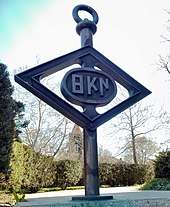
Alumni have also led several companies, including BitTorrent (Eric Klinker), Renaissance Technologies (Robert Mercer), Ticketmaster, McDonald's, Goldman Sachs, BP, Kodak, Shell, General Motors, Playboy, AT&T, General Electric, and Flipkart.
Alumni have founded many organizations, including the Susan G. Komen for the Cure and Project Gutenberg, and have served in a wide variety of government and public interest roles. Rafael Correa, President of The Republic of Ecuador since January 2006 secured his M.S. and PhD degrees from the university's Economics Department in 1999 and 2001 respectively.[174] Nathan C. Ricker attended U of I and in 1873 was the first person to graduate in the United States with a degree in Architecture. Mary L. Page, the first woman to obtain a degree in architecture, also graduated from U of I.[175] Disability rights activist and co-organizer of the 504 Sit-in, Kitty Cone, attended during the 1960s, but left 6 hours short of her degree to continue her activism in New York.[176]
In sports, baseball pitcher Ken Holtzman was a two-time All Star major leaguer, and threw two no-hitters in his career.[177] In sports entertainment, David Otunga became a two-time WWE Tag Team Champion.
Eta Kappa Nu (HKN) was founded as the national honor society for electrical engineering in 1904. Maurice LeRoy Carr (B.S. 1905) and Edmund B. Wheeler (B.S. 1905) were part of the founding group of ten students and they served as the first and second national presidents of HKN. The Eta Kappa Nu organization is now the international honor society for IEEE as the IEEE-Eta Kappa Nu (IEEE-HKN). The U of I collegiate chapter is known as the Alpha Chapter of HKN.
Philanthropy
Over the last twenty years state funding for the university has fallen from 44.5% to 16.4%. Private philanthropy increasingly supplements revenue from tuition and state funding, currently providing about 19% of the annual budget.[33] Notable among significant donors, alumnus entrepreneur Thomas M. Siebel has committed nearly $150 million to the university including $36 million to build the Thomas M. Siebel Center for Computer Science and the Grainger Foundation founded by alumnus W. W. Grainger has contributed more than $300 million to the university over the last half-century.
See also
- Carrie Thomas Alexander-Bahrenberg, university trustee until 1912
- HoTDeC, test bed for autonomous vehicles
References
- As of June 30, 2019. "U.S. and Canadian 2019 NTSE Participating Institutions Listed by Fiscal Year 2019 Endowment Market Value, and Percentage Change in Market Value from FY18 to FY19 (Revised)". National Association of College and University Business Officers and TIAA. Retrieved April 22, 2020.
- "Meet the Chancellor". illinois.edu. Archived from the original on September 27, 2016. Retrieved September 26, 2016.
- "Cangellaris, Andreas – Office of the Provost". Archived from the original on March 10, 2018. Retrieved March 9, 2018.
- "UIUC Student Enrollment by Curriculum and Student Level Fall 2019". University of Illinois at Urbana–Champaign. Archived from the original on October 8, 2019. Retrieved October 8, 2019.
- "Campus Facts". University of Illinois at Urbana–Champaign. Archived from the original on August 28, 2017. Retrieved August 30, 2017.
- "Logos and Colors | Illinois Brand Guidelines". August 14, 2017. Archived from the original on September 4, 2017. Retrieved September 5, 2017.
- "Illinois Identity Standards". University of Illinois – Office of Public Affairs. Archived from the original on August 13, 2016. Retrieved August 14, 2016.
- "Campus Administrative Manual – Urbana–Champaign Campus Designation". University of Illinois Office of the Chancellor. Archived from the original on March 6, 2016. Retrieved August 14, 2016.
- "Carnegie Classifications Institution Lookup". carnegieclassifications.iu.edu. Center for Postsecondary Education. Retrieved July 25, 2020.
- "Table 20. Higher education R&D expenditures, ranked by FY 2018 R&D expenditures: FYs 2009–18". ncsesdata.nsf.gov. National Science Foundation. Retrieved July 25, 2020.
- "By the Numbers - Office of the Vice Chancellor for Research". research.illinois.edu. Archived from the original on July 31, 2016. Retrieved August 6, 2016.
- American Library Association, "ALA Library Fact Sheet 22 – The Nation's Largest Libraries: A Listing by Volumes Held Archived June 19, 2010, at the Wayback Machine". July 2010.
- "The National Center for Supercomputing Applications at the University of Illinois at Urbana-Champaign". www.ncsa.illinois.edu. Archived from the original on December 24, 2012. Retrieved December 11, 2012.
- "Academics | Academics | University of Illinois Urbana–Champaign". illinois.edu. Archived from the original on March 25, 2018. Retrieved March 20, 2018.
- "PROSPECTUS FOR THE POSITION OF CHANCELLOR, University of Illinois at Urbana-Champaign and VICE PRESIDENT, University of Illinois" (PDF). University of Illinois President's Office. Spring 2016. Archived (PDF) from the original on June 30, 2018. Retrieved May 16, 2019.
- "Daily Illini". Illinois Digital Newspaper Collections. January 1, 1879. Archived from the original on July 21, 2015. Retrieved July 20, 2015.
- Illini Years: A Picture History of the University of Illinois (1950). p. 6
- Brichford, Maynard. "A Brief History of the University of Illinois". A Brief History of the University of Illinois. University of Illinois Archives. Archived from the original on August 23, 2015. Retrieved September 17, 2015.
- Brichford, Maynard. (1983), A Brief History of the University of Illinois Archived June 15, 2007, at the Wayback Machine
- McGinty, Alice. "The Story of Champaign-Urbana" Archived February 14, 2016, at the Wayback Machine Champaign Public Library
- "Facts | Illinois". Illinois.edu. Archived from the original on August 11, 2011. Retrieved July 29, 2012.
- "About the University Library". About the University Library. University of Illinois. Archived from the original on October 3, 2015. Retrieved September 17, 2015.
- "University of Illinois Campus Tour- Alma Mater". Archived from the original on July 8, 2010. Retrieved June 13, 2007.
- Leetaru, Kalev. "Hallene Gateway". University of Illinois: Virtual Campus Tour. UIHistories. Archived from the original on October 18, 2015. Retrieved September 18, 2015.
- "LAS: About Us: History". University of Illinois College of Liberal Arts & Sciences. Archived from the original on October 23, 2005. Retrieved April 8, 2006.
- Solberg, Winton U. (2004) "Edmund Janes James Builds a Library: The University of Illinois Library, 1904–1920" Libraries & Culture 39(1): pp. 36–75 [67]
- Solberg, Winton U. (2004) "Edmund Janes James Builds a Library: The University of Illinois Library, 1904–1920" Libraries & Culture 39(1): pp. 36–75 [37]
- Mary Timmins, "Enter the Dragon" Archived September 6, 2015, at the Wayback Machine, Illinois Alumni Magazine December 15, 2011.
- "Alma Mater". University of Illinois: Virtual Campus Tour. University of illinois. Archived from the original on October 18, 2015. Retrieved September 18, 2015.
- "David . Henry, 89, President Of Illinois U. in Time of Tumult". The New York Times. September 7, 1995. Archived from the original on May 19, 2017. Retrieved February 20, 2017.
- Peterson, Doug, 2015, "The (Water) Fighting Illini," Illinois Alumni Spring 2015, pp. 34–35.
- "University of Illinois FY2010 Budget Request" (PDF). Archived (PDF) from the original on June 16, 2011. Retrieved May 26, 2011.
- "Budget by Source of Funds | Stewarding Excellence @ Illinois". Oc.illinois.edu. Archived from the original on March 5, 2012. Retrieved July 29, 2012.
- "Frequently Asked Questions". Carle Illinois College of Medicine. Archived from the original on June 1, 2015. Retrieved April 27, 2015.
- "U. of I. pitches new medical school". Chicago Tribune. September 30, 2015. Archived from the original on April 20, 2015. Retrieved April 27, 2015.
- "U. of I., Carle moving forward with the first engineering-based college of medicine". Illinois News Bureau. March 12, 2015. Archived from the original on May 2, 2015. Retrieved April 27, 2015.
- "Core curriculum committee formed for Carle Illinois College of Medicine" (PDF). University of Illinois. December 10, 2015. Archived from the original (PDF) on March 28, 2016. Retrieved June 23, 2016.
- "Campus map". Archived from the original on November 7, 2005. Retrieved November 23, 2005.
- "Campus Landmarks". Archived from the original on August 19, 2007. Retrieved August 30, 2007.
- Shari L. Ellertson. "Expenditures on O&M at America's Most Beautiful Campuses". APPA. Archived from the original on February 19, 2008. Retrieved July 24, 2007.
- Committee on Campus Operations. UIUC Senate Archived September 6, 2006, at the Wayback Machine. April 26, 2004.
- "Student Sustainability Committee". Archived from the original on January 22, 2017. Retrieved December 15, 2016.
- "University of Illinois". Archived from the original on October 3, 2011. Retrieved December 9, 2011.
- "LEED Certifications". Archived from the original on February 14, 2017. Retrieved February 15, 2017.
- "Chancellor directs trustees' attention to faculty salaries". Retrieved October 15, 2008.
- "American College & University Presidents Climate Commitment" (PDF). Archived from the original (PDF) on March 1, 2013. Retrieved October 20, 2013.
- Lawsuit accuses former U of I professor of sexually assaulting, harassing students, Chicago Sun-Times, 10 September 2019, https://chicago.suntimes.com/2019/9/10/20859837/lawsuit-accuses-former-university-illinois-professor-sexually-assaulting-harassing-students Archived September 15, 2019, at the Wayback Machine
- Former University of Illinois professor accused of sexual and physical abuse: "He tried to kill me", CBS News, https://www.cbsnews.com/news/gary-xu-former-university-of-illinois-professor-accused-of-sexual-abuse/ Archived September 18, 2019, at the Wayback Machine
- "Students use email to serve sex abuse lawsuit to former U. of I. professor Gary Xu," Chicago Tribune, 26 December 2019.
- "Students Serve Ex-U of I Prof With Sexual Assault Suit via Email," NBC Chicago, 27 December 2019.
- One Campus. Seven Professors Facing Harassment Accusations. Few Consequences. ProPublica, https://www.propublica.org/article/university-of-illinois-urbana-champaign-professors-sexual-harassment-accusations Archived September 16, 2019, at the Wayback Machine
- "One Campus. Seven Professors Facing Harassment Accusations. Few Consequences," ProPublica 10 October 2019.
- "University of Illinois Academics". University of Illinois at Urbana–Champaign. Archived from the original on February 10, 2017. Retrieved February 15, 2017.
- "Leadership Certificate". Illinois Leadership Center. Archived from the original on December 22, 2015. Retrieved December 15, 2015.
- "University of Illinois–Urbana–Champaign". U.S. News & World Report. 2015. Archived from the original on January 6, 2016. Retrieved November 13, 2015.
- "Freshman Class Profile, Illinois Admissions". admissions.illinois.edu. Archived from the original on November 18, 2015. Retrieved November 30, 2015.
- "Illinois' very own college admissions scandal: Editorials from a shameful chapter in U. of I. history". Chicago Tribune.
- Jackson, Cheryl V. "The online MBA: Advantages, disadvantages in growing trend". chicagotribune.com. Archived from the original on January 22, 2018. Retrieved January 21, 2018.
- Wang, Amy X. "Coursera is offering a way to get a real master's degree for a lot less money". Quartz. Archived from the original on January 22, 2018. Retrieved January 21, 2018.
- "Best Graduate Computer Science Programs". U.S. News & World Report. January 21, 2018. Archived from the original on March 14, 2017. Retrieved January 21, 2018.
- "University of Illinois at Urbana–Champaign, HEC Paris Launch Master's Degrees on Coursera – Campus Technology". Campus Technology. Archived from the original on January 22, 2018. Retrieved January 21, 2018.
- "Master's in Accounting – iMSA by University of Illinois | Coursera". Coursera. Archived from the original on January 22, 2018. Retrieved January 21, 2018.
- "Master of Computer Science in Data Science | Coursera". Coursera. Archived from the original on January 22, 2018. Retrieved January 21, 2018.
- "Academic Ranking of World Universities 2020: National/Regional Rank". Shanghai Ranking Consultancy. Retrieved August 15, 2020.
- "America's Top Colleges 2019". Forbes. Retrieved August 15, 2019.
- "U.S. College Rankings 2020". Wall Street Journal/Times Higher Education. Retrieved September 26, 2019.
- "Best Colleges 2020: National University Rankings". U.S. News & World Report. Retrieved September 8, 2019.
- "2019 National University Rankings". Washington Monthly. Retrieved August 20, 2019.
- "Academic Ranking of World Universities 2020". Shanghai Ranking Consultancy. 2020. Retrieved August 15, 2020.
- "QS World University Rankings® 2021". Quacquarelli Symonds Limited. 2020. Retrieved June 10, 2020.
- "World University Rankings 2020". THE Education Ltd. Retrieved September 14, 2019.
- "Best Global Universities Rankings: 2020". U.S. News & World Report LP. Retrieved October 22, 2019.
- "University of Illinois-Urbana-Champaign - U.S. News Best Grad School Rankings". U.S. News & World Report. Retrieved April 28, 2020.
- "University of Illinois-Urbana-Champaign - U.S. News Best Global University Rankings". U.S. News & World Report. Retrieved April 28, 2020.
- "University of Illinois–Urbana–Champaign". U.S. News & World Report. Archived from the original on October 7, 2019. Retrieved September 11, 2019.
- "University of Illinois–Urbana–Champaign Rankings". U.S. News & World Report. Archived from the original on October 7, 2019. Retrieved September 11, 2019.
- "2019 National University Rankings". Washington Monthly. August 25, 2019. Archived from the original on August 27, 2019. Retrieved September 11, 2019.
- "Kiplinger's Best College Values – Public Colleges". The Kiplinger Washington Editors. July 2019. Archived from the original on August 23, 2019. Retrieved September 11, 2019.
- "The Top Schools For Urban Planners". Planetizen - Urban Planning News, Jobs, and Education. Archived from the original on July 3, 2019. Retrieved September 11, 2019.
- Greene, Howard R.; Greene, Matthew W. (2001). The public ivies: America's flagship public universities (1st ed.). New York: Cliff Street Books. ISBN 978-0060934590.
- "Top party schools named by the Princeton Review". CBS News. August 3, 2015. Archived from the original on November 17, 2015. Retrieved November 13, 2015.
- "Academic Ranking of World Universities 2016". ShanghaiRanking Consultancy. Archived from the original on July 31, 2019. Retrieved September 11, 2019.
- | Top Universities in the World "Archived copy" Check
|url=value (help). cwur.org. Archived from the original on September 7, 2019. Retrieved September 11, 2019.CS1 maint: archived copy as title (link) - "The top 50 universities by reputation 2018". Times Higher Education (THE). May 30, 2018. Archived from the original on June 12, 2018. Retrieved June 7, 2018.
- "2018 tables: Institutions - academic | 2018 tables | Institutions - academic | Nature Index". www.natureindex.com. Archived from the original on June 12, 2018. Retrieved June 7, 2018.
- "Research- The Center for Measuring University Performance" (PDF). Mup.asu.edu. Archived from the original (PDF) on October 20, 2012. Retrieved July 29, 2012.
- "Research- The Center for Measuring University Performance". Mup.asu.edu. Archived from the original on June 17, 2012. Retrieved July 29, 2012.
- "About Us: Buildings and Facilities – ECE ILLINOIS | University of Illinois at Urbana–Champaign". Ece.uiuc.edu. Archived from the original on August 28, 2008. Retrieved July 29, 2012.
- "EnterpriseWorks Incubator". Research Park at Illinois. Archived from the original on May 7, 2015. Retrieved April 27, 2015.
- "Urbana Named a Top Startup City by Popular Mechanics". Research Park at Illinois. January 14, 2015. Archived from the original on April 30, 2015. Retrieved April 27, 2015.
- "About". Research Park at Illinois. Archived from the original on May 4, 2015. Retrieved April 27, 2015.
- "National Science Board Approves Funds for Petascale Computing Systems". Archived from the original on August 31, 2007. Retrieved August 24, 2007.
- Feldman, Michael (November 14, 2011). "NCSA Signs Up Cray for Blue Waters Redo". HPC Wire. Archived from the original on February 16, 2013. Retrieved December 11, 2012.
- "Blue Waters system stats". www.ncsa.illinois.edu. Archived from the original on October 28, 2012. Retrieved December 11, 2012.
- "Blue Waters One Year Later: Delivering Sustained Petascale Science". www.ncsa.illinois.edu. Archived from the original on January 25, 2013. Retrieved December 11, 2012.
- Archived October 6, 2008, at the Wayback Machine
- "Remarks by Bill Gates". Archived from the original on July 5, 2007. Retrieved July 5, 2007.CS1 maint: BOT: original-url status unknown (link)
- Department of Computer Science. "News & Events | Department of Computer Science at Illinois". Cs.uiuc.edu. Archived from the original on October 16, 2007. Retrieved July 29, 2012.
- "Computer Science Department Calendar". Archived from the original on October 16, 2007. Retrieved June 21, 2016.
- Bollinger, Karen (March 7, 2016). "Illinois Earns Highest Honors from UPCEA". Illinois-Online. Archived from the original on April 7, 2016. Retrieved March 30, 2016.
- "Student Entrepreneurship". Archived from the original on July 19, 2019. Retrieved November 12, 2019.
- "What is TEC?". Archived from the original on October 24, 2019. Retrieved October 24, 2019.
- "Cozad New Venture Challenge". Archived from the original on October 24, 2019. Retrieved October 24, 2019.
- "Silicon Valley Entrepreneurship Workshop Application Due Sept. 30, 2019". Retrieved October 24, 2019.
- "NSF Innovation Corps". Archived from the original on November 4, 2019. Retrieved October 24, 2019.
- "Illinois I-Corps". Archived from the original on July 9, 2019. Retrieved October 24, 2019.
- "SocialFuse". Archived from the original on October 24, 2019. Retrieved November 14, 2019.
- "John Bardeen, Nobelist, Inventor of Transistor, Dies". Washington Post. January 31, 1991. Archived from the original on November 2, 2012. Retrieved August 3, 2007.
- Levey Larson, Debra (August 2003). "Supersweet sweet corn: 50 years in the making". Inside Illinois. University of Illinois at Urbana–Champaign. 23 (3). Archived from the original on October 12, 2008. Retrieved September 3, 2009.
- Andrew Stiller, "Hiller, Lejaren (Arthur)", Grove Music Online (reviewed December 3, 2010; accessed December 14, 2014).
- Denis L. Baggi, "The Role of Computer Technology in Music and Musicology Archived July 22, 2011, at the Wayback Machine", lim.dico.unimi.it (December 9, 1998).
- "The LLVM Compiler Infrastructure Project". llvm.org. Archived from the original on May 3, 2004. Retrieved January 20, 2017.
- Vetter, Ronald J. (October 1994). "Mosaic and the World-Wide Web" (PDF). North Dakota State University. Archived from the original (PDF) on August 24, 2014. Retrieved November 20, 2010.
- Don Bitzer, Email.
- CSL Quarterly Report for June, July, August 1960 (Report). Coordinated Science Laboratory, University of Illinois. September 1960.
- "100 Important Innovations That Came From University Research - Online Universities". OnlineUniversities.com. August 27, 2012. Archived from the original on May 16, 2019. Retrieved May 16, 2019.
- Falk, Joni K.; Drayton, Brian (2015). Creating and Sustaining Online Professional Learning Communities. Teachers College Press. pp. 8–. ISBN 978-0807772140. Archived from the original on July 9, 2014. Retrieved May 30, 2014.
- Bidgoli, Hossein (2004). The Internet Encyclopedia. John Wiley & Sons. pp. 665–. ISBN 978-0471222040. Retrieved May 30, 2014.
- Tykociner, Joseph T., "Photographic recording and photoelectric reproduction of sound," Trans. SMPE, no. 16, 90-119, 1923. cited in Archived December 13, 2016, at the Wayback Machine Kellogg, Edward W., History of Sound Motion Pictures, First Installment. Journal of the SMPTE, 1955, June, pp. 291–302. retrieved December 17, 2006
- "Illinois VENTURES – UofI Alumni Founded Companies". illinoisventures.com. Archived from the original on December 1, 2017. Retrieved November 23, 2017.
- Afridi, Ali (July 23, 2015). "Tech companies started by University of Illinois alum". Medium. Archived from the original on December 28, 2017. Retrieved December 27, 2017.
- "Jerry Colangelo profile". NBA.com. Archived from the original on July 13, 2018. Retrieved December 27, 2017.
- "Enrollment Spring 2018". UIUC Student Enrollment Spring 2018. UIUC. Archived from the original on February 20, 2018. Retrieved February 2, 2018.
- "Illinois launches Chinese-language broadcasts of football games Archived July 10, 2017, at the Wayback Machine." The Guardian. Saturday September 19, 2015. Retrieved on October 16, 2015.
- "Enrollment 2015". UIUC Student Enrollment. UIUC campus. Archived from the original on September 15, 2015. Retrieved September 18, 2015.
- "Students". Campus Facts. University of Illinois Urbana Champaign. Archived from the original on September 5, 2015. Retrieved September 18, 2015.
- "Enrollment Fall 2015". UIUC Student Enrollment Fall 2015. UIUC. Archived from the original on October 18, 2015. Retrieved October 16, 2015.
- Elizabeth Redden, "The University of China at Illinois," Inside Higher Education Jan 7, 2015 Archived January 7, 2015, at the Wayback Machine
- "University of Illinois at Urbana–Champaign". Illinois.collegiatelink.net. Archived from the original on July 24, 2012. Retrieved July 29, 2012.
- "Programs and Activities". Union.uiuc.edu. Archived from the original on June 22, 2012. Retrieved July 29, 2012.
- "About Us – Varsity Men's Glee Club". Archived from the original on October 11, 2016. Retrieved June 21, 2016.
- "Men's Glee Club to Host Choral Conference". April 17, 2006. Archived from the original on February 20, 2016. Retrieved June 21, 2016. Cite journal requires
|journal=(help) - "Chapter Standing". Alpha Phi Omega National Service Fraternity. Archived from the original on August 7, 2019. Retrieved August 7, 2019.
- Fraternity & Sorority Affairs :: University of Illinois Archived January 9, 2019, at the Wayback Machine. Odos.uiuc.edu. Retrieved on August 7, 2013.
- "Fraternity and Sorority Affairs". Archived from the original on December 7, 2008. Retrieved September 22, 2008.
- "IFC chapter membership". Archived from the original on December 24, 2005. Retrieved April 24, 2006.
- About – Black Greek Council Archived March 10, 2016, at the Wayback Machine. http://www.illinoisbgc.org/ Archived March 10, 2016, at the Wayback Machine. Retrieved on March 8, 2016.
- About Us – United Greek Council at UIUC Archived March 10, 2016, at the Wayback Machine. http://www.illinoisugc.org . Retrieved on March 8, 2016.
- Solberg, Winton (September 1966). "The University of Illinois and the Reform of Discipline in the Modern University, 1868-1891". AAUP Bulletin. 52 (3): 305–314. doi:10.2307/40224166. JSTOR 40224166.
- "Student Council, Committee Hold Dinner Meeting". Daily Illini. November 16, 1933. Archived from the original on November 17, 2015. Retrieved October 20, 2014.
- "Graduate Student Association Subject File, 1967–71" (PDF). University of Illinois. Retrieved July 17, 2012.
- Blan, Ken (February 4, 1967). "First GSA Meeting Monday". Daily Illini. Archived from the original on January 27, 2016. Retrieved October 20, 2014.
- "Student Senate Files, 1948–2008". University of Illinois. Retrieved July 17, 2012.
- "ISS Executive Board". Iss.illinois.edu. Archived from the original on October 4, 2012. Retrieved July 29, 2012.
- "Private Certified Housing FAQ". Private Certified Housing University of Illinois. 2016. Archived from the original on November 2, 2016. Retrieved November 4, 2016.
- Wurth, Julie (September 16, 2015). "Education secretary visits UI as part of national tour". The News Gazette. Archived from the original on September 19, 2015. Retrieved September 21, 2015.
- "Beckwith Residential Support Services at Nugent Hall". Archived from the original on April 2, 2015. Retrieved April 19, 2015.
- "University makes strides to honor first Native American alumnus". The Daily Illini. April 22, 2015. Archived from the original on August 8, 2015. Retrieved August 9, 2015.
- Roebuck, Gary; Morris, Shaneka; Kyrillidou, Martha (October 6, 2011). "ARL Statistics 2009-2010". Archived from the original on May 16, 2019. Retrieved May 16, 2019 – via publications.arl.org. Cite journal requires
|journal=(help) - "About the Main Stacks". Library.illinois.edu. Archived from the original on December 20, 2016. Retrieved December 2, 2016.
- "University and College Rankings". Archived from the original on September 15, 2008. Retrieved September 15, 2008.CS1 maint: BOT: original-url status unknown (link)
- "What our users were doing on Snapshot Day". Library.illinois.edu. Archived from the original on May 16, 2013. Retrieved July 29, 2012.
- "Living-Learning Communities | University Housing at Illinois". Housing.uiuc.edu. Archived from the original on March 11, 2009. Retrieved July 29, 2012.
- "Residence Hall Libraries". Archived from the original on March 11, 2009. Retrieved July 29, 2012.
- "About Us". Archived from the original on July 25, 2008. Retrieved April 14, 2008.
- "Home: UIUC Rare Book and Manuscript Library: UIUC Rare Books and Manuscript Library". Archived from the original on June 8, 2015. Retrieved May 29, 2015.
- "About the Library". Archived from the original on May 5, 2015. Retrieved May 29, 2015.
- "The Kolb–Proust Archive for Research". Archived from the original on June 8, 2015. Retrieved May 29, 2015.
- "Book Collections". Archived from the original on May 5, 2015. Retrieved May 29, 2015.
- "Manuscript Collections". Archived from the original on May 5, 2015. Retrieved May 29, 2015.
- "Intramural Physical Education Building / IMPE". UIHistories Project. Archived from the original on October 18, 2015. Retrieved April 27, 2015.
- "Campus Recreation » University of Illinois". Campusrec.uiuc.edu. Archived from the original on July 9, 2006. Retrieved July 29, 2012.
- Kaler, Robin. "Urbana campus consolidates to single logo". news.illinois.edu. Archived from the original on September 4, 2017. Retrieved March 24, 2018.
- "Columbia Missourian — Tradition's beginnings mysterious". Archived from the original on October 24, 2006.
- "Origin of the University Homecoming" (PDF). Archived from the original (PDF) on February 19, 2006. Retrieved December 13, 2005.
- Staff (July 26, 2006). "Ice Arena Facility". University of Illinois, Division of Campus Recreation. Archived from the original on April 26, 2006. Retrieved August 22, 2006.
- Norwood, Robyn (August 6, 2005). "NCAA to crack down on hostile nicknames". Los Angeles Times. Archived from the original on November 5, 2016. Retrieved November 4, 2016.
- Academic Freedom and Tenure: The University of Illinois at Urbana–Champaign Archived May 1, 2015, at the Wayback Machine AAUP, April 2015, pp. 5–6
- Chris Quintana (September 13, 2018). "'Exhaustion, Confusion, and Anger': U. of Illinois Finds a Community at Odds Over Old Mascot". The Chronicle of Higher Education. Archived from the original on September 16, 2018. Retrieved September 16, 2018.
- "Nobel Laureates & Pulitzer Prize Winners". University of Illinois at Urbana–Champaign. Archived from the original on October 5, 2018. Retrieved October 1, 2018.
- Ali Mir (2001), Art ofn, Rizzoli International Publications, ISBN 0847823709
- "CTBUH Profile". Archived from the original on May 21, 2014. Retrieved May 29, 2015.
- "William F. Baker". www.SOM.com. December 19, 2011. Archived from the original on August 12, 2012. Retrieved July 29, 2012.
- Markey, Patrick. Ecuador's Correa leaps from outsider to take lead, Washington Post, October 11, 2006
- Professor Paul Kruty. Establishing Architecture at the University of Illinois Archived September 1, 2006, at the Wayback Machine. Last updated May 28, 2005.
- Cone, Kitty. "Kitty Richmond Cone" (PDF). University of Illinois Archive. Archived (PDF) from the original on August 17, 2017. Retrieved August 17, 2017.
- "Ken Holtzman - Society for American Baseball Research". sabr.org. Archived from the original on April 1, 2018. Retrieved April 1, 2018.
Further reading
- Hoddeson, Lillian. No Boundaries: University of Illinois Vignettes. (University of Illinois Press, 2004; ISBN 9780252072031)
- Hoganson, Kristin L. The Heartland: An American History (Penguin Random House, 2019) online reviews
- Kanfer, Alaina. Illini Loyalty: The University of Illinois. (University of Illinois Press, 2011; ISBN 9780252035005)
- Solberg, Winton U. The University of Illinois, 1894-1904: The Shaping of the University. (University of Illinois Press, 2000; ISBN 9780252025792)
External links
| Wikimedia Commons has media related to University of Illinois at Urbana–Champaign. |
- Official website

- University of Illinois Athletics website

- . New International Encyclopedia. 1905.

